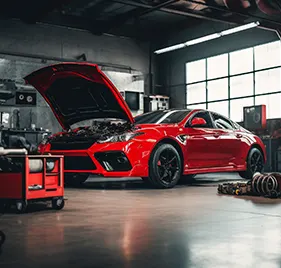Experiencing an auto part failure can be frustrating, especially when your vehicle is under warranty. Understanding how to navigate this situation is crucial for ensuring you receive the coverage you're entitled to and get back on the road quickly. From documenting the issue to filing a claim, the process requires attention to detail and knowledge of your rights as a consumer.
Understanding automotive warranty coverage and part failure
Automotive warranties are designed to protect consumers from defects in materials or workmanship for a specified period. However, not all part failures are automatically covered. It's essential to understand the nuances of your specific warranty to determine if a failed part qualifies for replacement or repair at no cost to you.
Typically, warranties cover major components such as the engine, transmission, and drivetrain. However, coverage can vary significantly between manufacturers and even between different models from the same brand. Some warranties may also include provisions for wear and tear items, though these are often subject to more stringent conditions.
When a part fails, the first step is to determine whether it's likely to be covered under your warranty. This often depends on factors such as the age of your vehicle, its mileage, and the nature of the failure. For instance, a transmission failure at 30,000 miles would typically be covered, while worn brake pads at the same mileage might not be.
Immediate steps after auto part failure detection
Upon detecting a part failure, it's crucial to take immediate action to protect your rights under the warranty and ensure a smooth claims process. The following steps should be taken as soon as possible:
Documenting the failure: photographic and video evidence
Visual evidence can be invaluable when filing a warranty claim. Take clear, well-lit photographs of the failed part if possible. If the failure is accompanied by unusual noises or performance issues, consider recording a video that captures these symptoms. This documentation can serve as crucial evidence if there's any dispute about the nature or extent of the failure.
Reviewing your vehicle's specific warranty terms
Locate your warranty documentation and review it carefully. Pay attention to:
- The duration and mileage limits of your coverage
- Specific parts or systems that are included or excluded
- Any conditions that might void your warranty
- The process for filing a claim
Understanding these details will help you navigate the claim process more effectively and avoid potential pitfalls that could jeopardize your coverage.
Contacting the dealership or authorized service center
Once you've documented the issue and reviewed your warranty, contact your dealership or an authorized service center. Explain the problem in detail and inform them that you believe the failed part should be covered under warranty. Schedule an appointment for inspection and diagnosis as soon as possible.
It's important to note that continuing to drive a vehicle with a known issue could potentially exacerbate the problem and complicate your warranty claim. If the failure affects your vehicle's safety or drivability, consider having it towed to the service center.
Preserving the failed part for inspection
If possible, preserve the failed part in its current condition. Do not attempt repairs or modifications, as this could void your warranty coverage. The manufacturer may request to inspect the part to determine the cause of failure and verify warranty eligibility.
Navigating the warranty claim process
Once you've taken the initial steps to document and report the failure, you'll need to navigate the warranty claim process. This can be complex, but understanding each step can help ensure a successful outcome.
Filing a formal warranty claim with the manufacturer
While the dealership or service center will often handle much of the claim process, it's important to understand how to file a formal claim with the manufacturer if necessary. This typically involves:
- Gathering all relevant documentation, including your warranty information, service records, and evidence of the failure
- Contacting the manufacturer's customer service or warranty department
- Providing a detailed description of the issue and any steps you've already taken
- Requesting a claim number or reference for future correspondence
- Following up regularly to ensure your claim is being processed
Keep detailed records of all communications, including dates, times, and the names of representatives you speak with. This information can be crucial if you need to escalate your claim later.
Preparing for diagnostic tests and inspections
The service center will likely need to perform diagnostic tests to determine the exact cause of the failure. Be prepared to leave your vehicle for this process, which may take several days. Ask for a detailed explanation of the diagnostic process and any associated costs. While diagnostic fees are sometimes covered under warranty, this isn't always the case.
If the diagnosis reveals that the failure is indeed covered by your warranty, the repair or replacement should proceed at no cost to you. However, if the service center determines that the issue isn't covered, you may need to decide whether to proceed with the repair at your own expense or seek a second opinion.
Understanding OEM vs. aftermarket part replacements
When replacing a failed part under warranty, manufacturers are generally required to use Original Equipment Manufacturer (OEM) parts. These are identical to the parts that were originally installed in your vehicle. However, in some cases, a manufacturer may offer the option of using aftermarket parts.
It's important to understand the implications of using aftermarket parts:
- They may affect future warranty coverage for related components
- The quality and fit may not be identical to OEM parts
- They could potentially impact your vehicle's performance or resale value
If you're offered aftermarket parts as a warranty replacement, carefully consider the pros and cons before agreeing. In most cases, insisting on OEM parts for warranty repairs is your best option.
Dealing with potential claim denials or disputes
Unfortunately, not all warranty claims are approved on the first attempt. If your claim is denied, don't be discouraged. You have several options:
- Request a detailed explanation of the denial in writing
- Seek a second opinion from another authorized service center
- Escalate your claim to a higher level within the manufacturer's organization
- Consider involving a third-party mediator or arbitrator
- As a last resort, explore legal options if you believe your claim has been unfairly denied
Remember, persistence and thorough documentation are key when dealing with disputed warranty claims.
Legal rights and consumer protection for warranty issues
Understanding your legal rights can be crucial when dealing with warranty issues. Several laws and regulations are in place to protect consumers in these situations.
Magnuson-moss warranty act and your consumer rights
The Magnuson-Moss Warranty Act is a federal law that governs consumer product warranties. Under this act, manufacturers and sellers of consumer products must provide consumers with detailed information about warranty coverage. Some key provisions include:
- Warranties must be clearly written and easily understood
- Warranties cannot be conditioned on the use of specific brands of parts or services
- Consumers have the right to compare warranty coverage before purchase
- Manufacturers must honor the terms of their written warranties
This act provides significant protections for consumers and can be a powerful tool when dealing with warranty disputes.
State lemon laws and their application to part failures
While most people associate lemon laws with entire vehicles, these state-specific regulations can sometimes apply to persistent part failures as well. If a warranted part fails repeatedly and the manufacturer is unable to repair it after a reasonable number of attempts, you may have recourse under your state's lemon law.
The specifics of lemon laws vary by state, but they generally require:
- A certain number of repair attempts (usually 3-4) for the same issue
- A specific amount of time that the vehicle is out of service for repairs
- The problem must substantially impair the vehicle's use, value, or safety
If your situation meets these criteria, you may be entitled to a replacement vehicle or a refund.
Arbitration vs. litigation for unresolved warranty disputes
When warranty disputes can't be resolved through normal channels, you may need to consider more formal resolution methods. The two primary options are arbitration and litigation.
Arbitration is often faster and less expensive than going to court. Many manufacturers have arbitration programs in place, some of which are administered by independent third parties. The Better Business Bureau's Auto Line program is one example of a widely recognized arbitration service for automotive warranty disputes.
Litigation should generally be considered a last resort due to its time and cost. However, in cases of significant financial loss or clear violations of consumer protection laws, it may be necessary. If you're considering legal action, consult with an attorney who specializes in consumer protection or automotive law.
Preventive measures and future considerations
While dealing with a failed part can be challenging, there are steps you can take to minimize future issues and protect your warranty coverage.
Maintaining service records for warranty compliance
Regular maintenance is crucial not only for your vehicle's longevity but also for maintaining your warranty coverage. Many warranties require that you follow the manufacturer's recommended maintenance schedule. Failure to do so could potentially void your warranty.
To protect yourself:
- Keep detailed records of all maintenance and repairs
- Use the manufacturer's recommended fluids and parts
- Have services performed at the intervals specified in your owner's manual
- If you perform your own maintenance, keep receipts for parts and document the work done
These records can be invaluable if you need to prove that you've complied with warranty requirements.
Extended warranty options for Post-Original coverage
As your original warranty nears expiration, you may want to consider an extended warranty. These can provide additional peace of mind, especially for older vehicles or those with high mileage. However, it's important to carefully evaluate extended warranty offers:
- Compare coverage details and exclusions between different plans
- Consider the reputation and financial stability of the warranty provider
- Evaluate the cost of the warranty against the potential cost of future repairs
- Be wary of high-pressure sales tactics or offers that seem too good to be true
Remember that not all extended warranties are created equal. Some may offer comprehensive coverage similar to your original warranty, while others may have significant limitations or exclusions.
Impact of DIY repairs on warranty validity
Many car enthusiasts enjoy performing their own maintenance and repairs. While this can save money and be personally rewarding, it's important to understand how DIY work can affect your warranty.
Generally, performing your own routine maintenance (such as oil changes or brake pad replacements) won't void your warranty, provided you use the correct parts and fluids and can document the work. However, more complex repairs or modifications could potentially affect your coverage.
To protect your warranty while enjoying DIY work:
- Stick to routine maintenance tasks unless you're very confident in your skills
- Use only OEM or manufacturer-approved parts and fluids
- Keep detailed records of all work performed, including parts receipts
- Avoid modifications that could affect vehicle systems or performance
- If in doubt, consult your warranty documentation or contact the manufacturer
By understanding your warranty, taking prompt action when issues arise, and maintaining your vehicle properly, you can maximize your protection and minimize the stress of dealing with part failures. Remember, your warranty is a valuable asset - use it wisely to keep your vehicle running smoothly for years to come.

